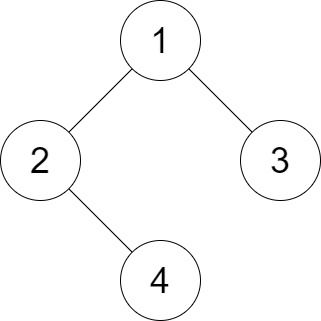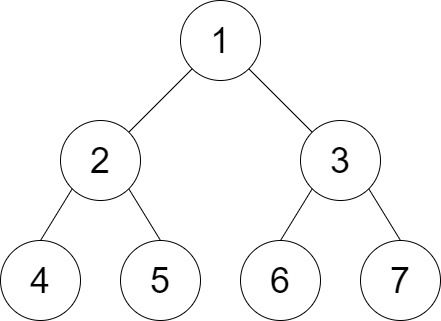给你二叉树的根节点 root 和一个整数 distance 。
如果二叉树中两个 叶 节点之间的 最短路径长度 小于或者等于 distance ,那它们就可以构成一组 好叶子节点对 。
返回树中 好叶子节点对的数量 。
示例 1:
输入:root = [1,2,3,null,4], distance = 3 输出:1 解释:树的叶节点是 3 和 4 ,它们之间的最短路径的长度是 3 。这是唯一的好叶子节点对。
示例 2:
输入:root = [1,2,3,4,5,6,7], distance = 3 输出:2 解释:好叶子节点对为 [4,5] 和 [6,7] ,最短路径长度都是 2 。但是叶子节点对 [4,6] 不满足要求,因为它们之间的最短路径长度为 4 。
示例 3:
输入:root = [7,1,4,6,null,5,3,null,null,null,null,null,2], distance = 3 输出:1 解释:唯一的好叶子节点对是 [2,5] 。
示例 4:
输入:root = [100], distance = 1 输出:0
示例 5:
输入:root = [1,1,1], distance = 2 输出:1
提示:
tree的节点数在[1, 2^10]范围内。- 每个节点的值都在
[1, 100]之间。 1 <= distance <= 10
方法一:递归
题目求一个二叉树好叶子节点的对数,答案可以拆分为三部分之和:左子树好叶子节点的对数、右子树好叶子节点的对数,以及左子树叶子节点与右子树叶子节点组成的好叶子节点的对数。
递归求解即可。
时间复杂度
# Definition for a binary tree node.
# class TreeNode:
# def __init__(self, val=0, left=None, right=None):
# self.val = val
# self.left = left
# self.right = right
class Solution:
def countPairs(self, root: TreeNode, distance: int) -> int:
def dfs(root, cnt, i):
if root is None or i >= distance:
return
if root.left is None and root.right is None:
cnt[i] += 1
return
dfs(root.left, cnt, i + 1)
dfs(root.right, cnt, i + 1)
if root is None:
return 0
ans = self.countPairs(root.left, distance) + self.countPairs(
root.right, distance
)
cnt1 = Counter()
cnt2 = Counter()
dfs(root.left, cnt1, 1)
dfs(root.right, cnt2, 1)
for k1, v1 in cnt1.items():
for k2, v2 in cnt2.items():
if k1 + k2 <= distance:
ans += v1 * v2
return ans/**
* Definition for a binary tree node.
* public class TreeNode {
* int val;
* TreeNode left;
* TreeNode right;
* TreeNode() {}
* TreeNode(int val) { this.val = val; }
* TreeNode(int val, TreeNode left, TreeNode right) {
* this.val = val;
* this.left = left;
* this.right = right;
* }
* }
*/
class Solution {
public int countPairs(TreeNode root, int distance) {
if (root == null) {
return 0;
}
int ans = countPairs(root.left, distance) + countPairs(root.right, distance);
int[] cnt1 = new int[distance];
int[] cnt2 = new int[distance];
dfs(root.left, cnt1, 1);
dfs(root.right, cnt2, 1);
for (int i = 0; i < distance; ++i) {
for (int j = 0; j < distance; ++j) {
if (i + j <= distance) {
ans += cnt1[i] * cnt2[j];
}
}
}
return ans;
}
void dfs(TreeNode root, int[] cnt, int i) {
if (root == null || i >= cnt.length) {
return;
}
if (root.left == null && root.right == null) {
++cnt[i];
return;
}
dfs(root.left, cnt, i + 1);
dfs(root.right, cnt, i + 1);
}
}/**
* Definition for a binary tree node.
* struct TreeNode {
* int val;
* TreeNode *left;
* TreeNode *right;
* TreeNode() : val(0), left(nullptr), right(nullptr) {}
* TreeNode(int x) : val(x), left(nullptr), right(nullptr) {}
* TreeNode(int x, TreeNode *left, TreeNode *right) : val(x), left(left), right(right) {}
* };
*/
class Solution {
public:
int countPairs(TreeNode* root, int distance) {
if (!root) return 0;
int ans = countPairs(root->left, distance) + countPairs(root->right, distance);
vector<int> cnt1(distance);
vector<int> cnt2(distance);
dfs(root->left, cnt1, 1);
dfs(root->right, cnt2, 1);
for (int i = 0; i < distance; ++i) {
for (int j = 0; j < distance; ++j) {
if (i + j <= distance) {
ans += cnt1[i] * cnt2[j];
}
}
}
return ans;
}
void dfs(TreeNode* root, vector<int>& cnt, int i) {
if (!root || i >= cnt.size()) return;
if (!root->left && !root->right) {
++cnt[i];
return;
}
dfs(root->left, cnt, i + 1);
dfs(root->right, cnt, i + 1);
}
};/**
* Definition for a binary tree node.
* type TreeNode struct {
* Val int
* Left *TreeNode
* Right *TreeNode
* }
*/
func countPairs(root *TreeNode, distance int) int {
if root == nil {
return 0
}
ans := countPairs(root.Left, distance) + countPairs(root.Right, distance)
cnt1 := make([]int, distance)
cnt2 := make([]int, distance)
dfs(root.Left, cnt1, 1)
dfs(root.Right, cnt2, 1)
for i, v1 := range cnt1 {
for j, v2 := range cnt2 {
if i+j <= distance {
ans += v1 * v2
}
}
}
return ans
}
func dfs(root *TreeNode, cnt []int, i int) {
if root == nil || i >= len(cnt) {
return
}
if root.Left == nil && root.Right == nil {
cnt[i]++
return
}
dfs(root.Left, cnt, i+1)
dfs(root.Right, cnt, i+1)
}

